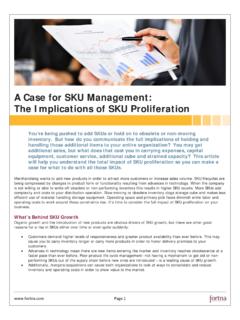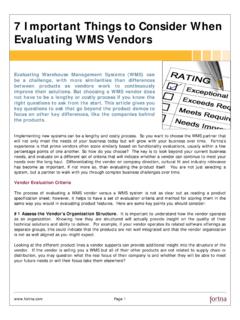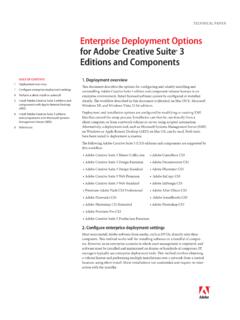Transcription of WP Keys to Successful Supply Chain …
1 Page 1 keys to Successful Supply Chain Transformation Weathering the Perfect Storm To maintain competitive advantage, organizations must change and evolve over time. Often, Supply Chain Leaders are responsible for delivering on the business case for organizational transformations. But major transformations are notorious for not delivering on the original intent of the change, and Supply Chain programs are not immune to these challenges. Executive Summary Riddled with cost and schedule overruns, critical projects often miss delivery results, negatively impact service, and directly affect profits.
2 This paper delves into the specific approaches, issues, and challenges of three companies that struggled with large-scale, business transforming programs. Despite their best intentions, these companies failed to deliver on the promised business value. As a result, customer service suffered, stock prices declined, organizational and personal reputations were damaged, and many careers were negatively impacted. These companies and individuals did not successfully weather the storm. keys to Successful Supply Chain Transformation Page 2 What s the Problem? Simply stated, large organizational change is hard.
3 Conner Partners has over thirty-five years of experience leading transformational change. They suggest the success rate for transformational business imperatives is only 30%; 70% fail to realize their full objectives. In further support, Martin E. Smith, PhD suggests the Success rate for different types of organizational change ranges between 19% and 46%, as shown below. Smith Success rates for different types of organizational change . And based on research by Jennifer A. LaClair and Ravi P. Rao, organizations most skilled at implementation realized 143% of their initiative s expected value.
4 But least-skilled organizations realized only 35% of the anticipated return. What s Wrong with the Traditional Approach to Supply Chain Projects? The traditional approach to large-scale change often consists of: Implementing multiple, disparate point solutions and/or systems without a comprehensive and integrated strategy, approach, and resource plan Not investing in clarifying and building sufficient leadership alignment around a common goal Failing to address the human side when determining if the organization is ready for implementation (addressing issues like resistance, commitment, cultural impact, etc.)
5 Failing to connect business goals with implementation efforts making it difficult to realize the business case as outlined and intended Limiting buy-in across all the stakeholders resulting in conflicting interests (what s in it for me?) Relying heavily on consultants and/or 3rd parties to drive success 19%20%26%30%33%37%46%0%5%10%15%20%25%30% 35%40%45%50%CultureChangeBusinessExpansi onSoftwareInstallationRe-EngineeringM&AT QM-DrivenChangeRestructuringKeys to Successful Supply Chain Transformation Page 3 Unfortunately, this traditional approach delivers unsatisfactory results including.
6 Key components of the business case are not met o True purpose of the initiative not fully accomplished o Diminished service levels o Increased operating costs o Stifled business growth Unrealized expectations o Loss of customer goodwill o Diminished reputation & negative impact on careers o Company value being downgraded by Wall Street or others o Morale issues Schedule delays Capital budget overruns Long stabilization periods o Excess labor o Poor service levels o Reactive vs. proactive approach to supporting business Case Studies The following table summarizes the journeys of three companies that embarked on less-than- Successful Supply Chain transformations.
7 Case Study 1: Specialty Retailer Case Study 2: Parts Wholesaler Case Study 3: Large Business Unit for Conglomerate Intended Business Imperative Enable Growth need for new DC (existing site at capacity); desire to drive sales through automated Value Added Services (VAS) ( personalization) Improve service levels through productivity and throughput improvements; reduce order cycle time 45% Implement IT strategy to improve support and reduce cost required move from homegrown to Tier 1 systems Enable Growth expansion from the Midwest to the West to take advantage of competitive opportunities Reduce transportation costs in dedicated network (closer to customers, fewer miles)
8 Improve customer service levels and response times Business Continuity redundant operations to alleviate cold weather issues which impacted operations and customer service commitments Enable Growth ability to support e-commerce strategy (no longer wholesaler only) Relocate facility to the South to reduce labor costs by 20% Improve customer service levels and response times to wholesale customer base (largest part of their business) People Multiple consulting firms engaged (separate firms for Conceptual Design, Detailed Design, Material Handling Equipment, Systems, etc.)
9 All training performed in a classroom setting (no floor training) - inhibited adoption Most users saw the new DC for the first time at go-live; only key people allowed prior access to the building Top management verbally supported program objectives, but failed to provide authority to work stream leads and accountability for results; leaders lacked courage and discipline - decision by consensus Program resources lacked in number, experience, level of dedication Resistance to adoption of best practices; maintain status quo Executives supported program objectives, but failed to consider key issues relative to order management, procurement, inventory management, processes, technology Project was very strategic lacked doers of the work Invested heavily in consultants to keep local staff from knowing what was happening keys to Successful Supply Chain Transformation Page 4 Business Case Study 1: Specialty Retailer Case Study 2: Parts Wholesaler Case Study 3.
10 Large Business Unit for Conglomerate Processes Added new processes for personalization (VAS), as well as quality audits Limited existing SOPs (operations, finance, HR, IT) Lacked program management structure (documentation, discipline, accountability) Lacked understanding of transition management and the impacts of change Cross-functional design processes not utilized Limited existing SOPs (operations, finance, HR, IT) Lacked program management structure (documentation, discipline, accountability) Lacked understanding of transition management and the impacts of change in processes Experienced workers in existing facility had tribal knowledge of processes.













